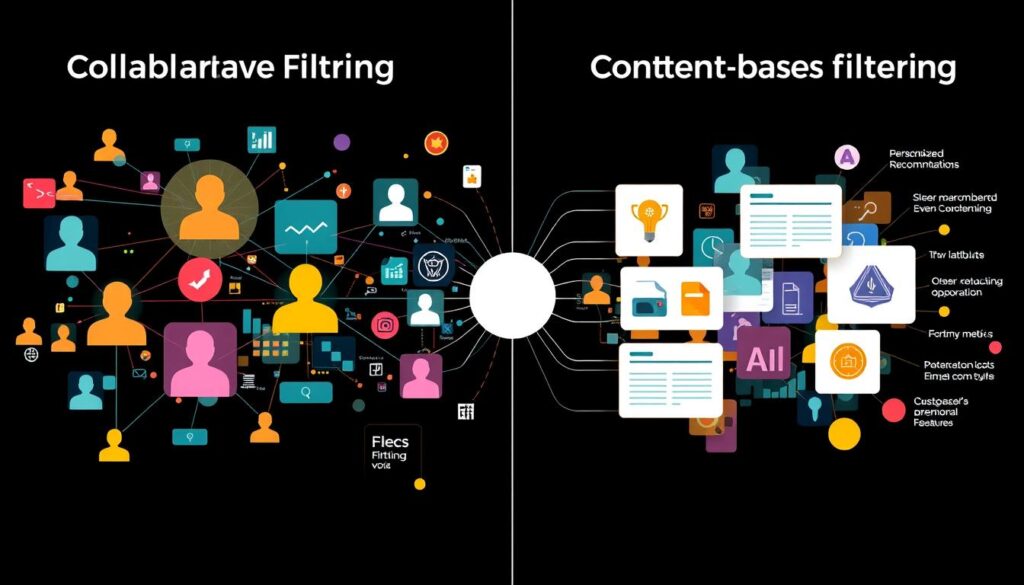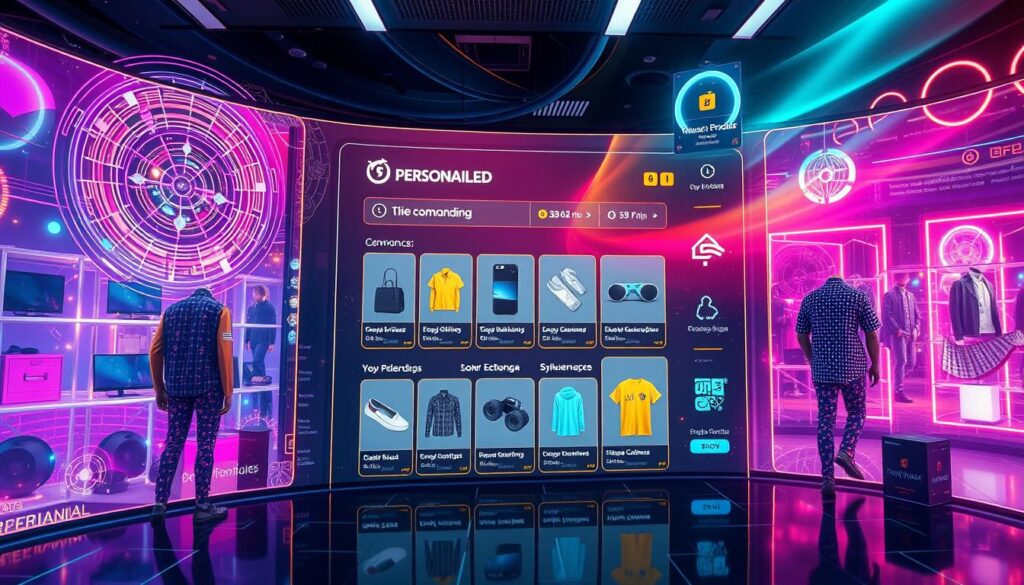Imagine scrolling through an online store. Instantly, you see products that seem just for you. Every recommendation connects with not just your past buys, but also with your hidden desires and preferences. This magical experience comes from AI in product and content recommendations. Today, shoppers want a shopping experience made just for them. To keep up, businesses have to change how they work.
With 71% of shoppers expecting personalized tips, ignoring this trend might cost you their loyalty. In a world so focused on personal touch, staying behind is not an option.
The growth of e-commerce personalization is backed by solid numbers. For example, 35% of Amazon purchases in 2021 came from recommendations. This shows how big an impact AI has on what we buy. AI like that used by Spotify looks at what users like. It then suggests music that suits each listener’s taste. This shows how important personal touches are today, across many areas.
So, tapping into AI for product recommendations isn’t just nice to have. It’s crucial for businesses that want to succeed. In a very competitive field, it’s what could set you apart.
Key Takeaways
- Personalized recommendations significantly enhance customer engagement and drive revenue growth.
- 71% of consumers expect tailored suggestions, with a majority feeling disappointed when not met.
- Generative AI analyzes user preferences to create customized experiences.
- AI algorithms contribute to 35% of purchases on platforms like Amazon.
- Understanding user behavior enhances the effectiveness of recommendations.
- Continual learning of AI systems offers real-time personalization, unlike traditional methods.
- Businesses leveraging AI-driven personalization achieve greater customer satisfaction and retention rates.
The Importance of Personalization in E-Commerce
Personalization is key in e-commerce success today. Shoppers want experiences made just for them. About 69% of them seek new products during their visits online or in-store. This shows how personalization importance can improve the shopping journey.
With more people using mobile devices, having AI for personalization is crucial. It helps boost sales both online and in-store. In fact, 57% of marketers believe personalization is vital for connecting with customers everywhere.
Companies see real benefits from personalization. For example, after engelhorn used Salesforce’s Einstein Product Recommendations, they saw a 2.5% rise in online conversion rates. Their revenue per visitor also went up nearly 4%. Icebreaker experienced a 40% increase in click rates for product recommendations. They also saw a 28% rise in revenue from these items.
Personalization makes customers happier. Research shows 80% prefer brands that offer personalized service. With AI, companies can suggest products that fit each customer. This approach can boost sales conversions by up to 20%, greatly benefiting e-commerce strategies.
E-commerce sites using AI personalization see a 30% jump in click-through rates. Brands delivering these experiences can increase customer retention by 25%. This is key in avoiding cart abandonment, which could cost around $18 billion yearly. The link between personalization and profit is undeniable. Indeed, 90% of top marketers say it’s essential for success.
Challenges in Providing Tailored Recommendations
Delivering personalized shopping tips online is tough. Retailers are trying to use AI to understand what you might like. But it’s hard to get it right all the time. Sometimes, this means you get suggestions that don’t make sense to you. This can be annoying.
Also, the systems aren’t perfect. They might suggest something you already bought. This doesn’t help in finding new things you might like.
Businesses want to make shopping online better for you. They’re using AI to suggest things without having to guess. But they have to be careful with your data and use it the right way. This isn’t always easy.
To really know what you might want, machines have to learn from lots of data. They look at what you’ve bought and what you like to browse. This helps make sure you see things that truly interest you.
By knowing what you might need before you do, businesses can keep you happier. They try to avoid annoying you with bad suggestions. And they aim to guess what you’ll want next, making your shopping experience better.

Understanding User Behavior for Effective Recommendations
To craft effective recommendations in e-commerce, it’s vital to understand user behavior. About 71% of shoppers now expect tailored experiences. This means businesses have to focus on analyzing user behavior to meet these expectations. They need to look at how users click, buy, and search to learn about customer preferences.
Studies reveal that 45% of shoppers might leave if they don’t get personalized experiences. So, businesses are using AI to make smart recommendations. This way, they can give users what they’re more likely to enjoy. AI systems study previous behavior to offer better suggestions that match evolving customer tastes.

Advanced algorithms can find shopping patterns focusing on item features. This makes for more fitting suggestions. Also, techniques like collaborative filtering take data from similar shoppers to recommend products. This keeps recommendations interesting for each user, enhancing their shopping experience and boosting sales.
As AI tech improves, it’s getting better at handling lots of data. This opens new doors for personalized marketing that keeps learning from user behavior. Businesses using this tech can make recommendations that really speak to each user’s needs.
Leveraging Generative AI for Personalization
Generative AI is changing how we personalize e-commerce strategies. It uses complex algorithms to study customer data, like shopping habits and likes. This lets businesses offer product suggestions that really match what each customer wants.
Now, we look beyond simple demographics. Generative AI helps stores truly understand their customers, making recommendations that match their interests. Studies show that good personalization can greatly increase sales and make customers happier.
- Automating the recommendation process with generative AI can save businesses time and resources.
- Higher customer engagement and improved satisfaction are direct benefits of implementing these advanced algorithms.
- Clear objectives and high-quality data are necessary for successful integration into existing systems.
Companies like Amazon, Netflix, and Spotify use generative AI to keep customers coming back. Amazon’s recommendations increase sales, while Spotify suggests playlists based on what you listen to. These show how powerful generative AI can be in marketing.
Using generative AI can also help businesses cut costs, especially on a big scale. Being able to handle more data and make smarter choices will be key in the future. By 2026, it’s expected that 30% of new software will use AI to make better user tools. That’s a big jump from less than 5% now.

Almost all marketing leaders think generative AI is key for better targeting. Personalization builds trust, makes shopping easier, and creates a real connection between shops and customers.
Data Sources for Creating Personalized Recommendations
E-commerce personalization depends on many data sources. These include purchase history, browsing habits, and customer likes and dislikes. They help create personalization data, guiding targeted marketing efforts. This data offers insights, improving how users interact with sites.
Use collaborative filtering to better recommend products. This can be memory-based or model-based. Product-based filtering looks at what items offer, recommending based on what users like. Mixing these techniques results in hybrid systems, combining the best of both worlds.

Many stores show the power of these tools. For example, End Clothing highlights items users have looked at before. Amazon suggests items that are often bought together. And boohoo.com uses AI to tailor what shoppers see, making shopping smoother.
Where and how you show recommendations matters a lot. You can put them on product pages, send them in emails, or use app notifications. It’s key not to show too many options at once. This can confuse buyers. For instance, ToolStation’s ‘You might also like’ section makes finding new products easy.
| Data Source | Example | Benefit |
|---|---|---|
| Purchase History | Amazon’s frequently bought together | Increases cross-selling opportunities |
| Browsing Patterns | End Clothing’s recently viewed items | Enhances user engagement |
| User Preferences | boohoo.com’s tailored recommendations | Improves relevance for the individual |
| Email Recommendations | Seasonal product highlights | Boosts conversion rates |
Amazon Personalize uses AI to create very personal user experiences. It learns from billions of interactions to update its recommendations. With generative AI, companies can better group customers. This makes suggestions even more relevant.
Analyzing Clickstream to Enhance User Insights
Clickstream analysis is a tool that helps businesses understand user paths on their sites. By tracking what users do online, companies learn valuable things to make websites better. This process shows which pages do well and which ones might need work.
Businesses use this data to find what content users like and their goals. Identifying where users stop can help improve the website flow and increase sales. Understanding click patterns allows businesses to see where they may need to fix their site’s layout.

Studying online behavior helps predict what users might do next. This can lead to making the website more user-friendly. Knowing which website parts are used most helps decide what to update first.
Clickstream analysis makes it possible to customize content and recommendations for users. This approach increases user interest and loyalty. It also helps companies know their audience better and tailor their products to meet user needs.
Adding user feedback like surveys into the mix makes products better. Analyzing things like bounce rates shows how happy or engaged users are. This gives a better idea of what users think about the website.
| Metric | Description |
|---|---|
| Bounce Rate | The percentage of visitors who leave the site after viewing only one page. |
| Exit Rate | The percentage of users who leave a site from a specific page, highlighting possible content issues. |
| Time on Page | The average duration a user spends on a page, indicating engagement level. |
| Page Views | The total number of pages viewed, which showcases content popularity. |
| Retention | The measure of how many users return to the site, reflecting loyalty. |
| Churn | The rate at which customers stop interacting with the site, critical for performance evaluation. |
Using tools like Google Analytics helps get a deep look at user behavior. Clickstream data uncovers issues in the conversion process and aids in making sites easier to use. Companies like Netflix and Amazon save a lot and keep many customers by using this data well.
Purchase History Analysis for Tailored Suggestions
Looking into purchase history gives businesses key insights. By understanding consumer buying patterns, they can offer tailored recommendations. This effort boosts customer happiness and encourages more sales.
For example, if someone often buys workout gear, the system suggests related items like clothes or supplements. This smart marketing helps both the shopper and the store. It builds a relationship based on trust and loyalty.

- Machine learning: Enables systems to learn from data, making smarter suggestions as they go.
- Natural Language Processing (NLP): Helps systems understand what customers want using everyday language.
- Big data analytics: Improves the analysis of big data for better predictions of what customers will do next.
Tailored suggestions are super important. Studies show many shoppers would switch brands for more personal recommendations. This shows how using data smartly can keep companies ahead in the game.
| Technique | Description |
|---|---|
| Collaborative Filtering | Finds what different users like and discovers shared tastes. |
| Content-Based Filtering | Suggests new products by looking at what was bought before. |
| Hybrid Models | Uses both above methods for sharper suggestions. |
Using tailored recommendations changes how customers and businesses bond. It makes shopping better, turning first-time buyers into loyal fans.
Search Query Analysis to Capture Customer Interests
Search query analysis is key to knowing what products customers want. It shows us the items customers are looking for online. This helps businesses understand customers better and recommend products they’ll likely buy.
Companies can match their products with what customers want through search query analysis. This approach makes shopping more personal. Customers are happier because suggestions fit exactly what they need.
Using artificial intelligence takes search query analysis up a notch. AI allows for smarter search techniques. It gives users results that are tailored just for them, making customers more loyal.

Here’s how businesses can use search query insights for smarter marketing:
| Method | Description |
|---|---|
| Keyword Tracking | Track specific keywords and phrases that attract user attention, facilitating focused marketing efforts. |
| User Behavior Analysis | Study patterns in user search queries to predict future preferences and tailor recommendations accordingly. |
| Adaptive Search Results | Utilize AI-powered tools to dynamically adapt search results in real-time based on user activity. |
| Feedback Loops | Solicit feedback from users on recommendations to refine and enhance future suggestion accuracy. |
Good search query analysis is vital for online stores to succeed. It lets businesses go beyond meeting customer needs to exceeding their expectations. This leads to long-term growth and new ideas.
The Power of Machine Learning Algorithms
Machine learning algorithms help improve product suggestions on various platforms. They sift through large data sets to better understand what customers like. For instance, Amazon used these algorithms to boost sales by 29% in the middle of 2012.
Data analysis techniques can vary. Collaborative filtering looks at the habits of customers who are alike. Content-based filtering, on the other hand, examines product specifics. These approaches help companies offer more personalized recommendations.

Hybrid models blend these strategies to make even more precise suggestions. For example, McKinsey found that 35% of Amazon purchases are based on algorithm suggestions. Netflix also says its recommendations influence about 75% of what users watch, factoring in things like time of year and user preferences.
This table shows how different platforms use technology to make recommendations:
| Platform | Method | Influence |
|---|---|---|
| Amazon | Collaborative Filtering | 29% sales increase after deployment |
| Netflix | Deep Learning | 75% of content watched is recommended |
| YouTube | Signal Analysis | Personalizes user experience |
| Deep Learning and Neural Networks | Enhances user engagement across the platform | |
| Recommendation Engine | Suggests job ads and connections based on user profile |
Google, Amazon, and Netflix boost engagement through AI-driven recommendation systems. The advancement of these algorithms offers unique personalization chances. Companies that invest in data analysis and machine learning not only enhance customer happiness but also increase sales.
Collaborative and Content-Based Filtering Explained
In the world of recommendation systems, two methods are key: collaborative filtering and content-based filtering. These approaches help make user experiences better by focusing on what users like.
Collaborative filtering looks at user behavior and connections. It finds users who like similar things and recommends items they might enjoy. For example, when people rate movies, the system uses these ratings to find patterns. It then makes new suggestions based on what users do together.
Content-based filtering, however, pays attention to the items themselves. It recommends things by looking at the characteristics of products or content. This approach uses recommendation algorithms to evaluate items based on their features or metadata.

Both of these methods have their own benefits. Content-based systems use detailed info on items, while collaborative filtering uses user history. This helps identify new trends. Yet, content-based filtering may be limited by its features, and collaborative filtering might not work well without enough user data.
Netflix shows how blending these methods can be powerful. It uses both to improve how users feel about their recommendations. As these algorithms get better, they make user experiences more personal. This leads to happier customers and more engagement.
AI in Product and Content Recommendations – Real-Life Applications
AI is changing the game in e-commerce and content delivery. It helps businesses offer better experiences to customers. For example, Amazon’s powerful AI looks at what you’ve bought before. It suggests new items you might like, increasing sales and making customers happy.
AI is not just about recommending products. It’s also making companies and governments more efficient. Local governments use AI to speed up their work and save money. This shows AI’s role in handling routine tasks and analyzing complex data.

Social media companies use AI to show you posts that match your interests. This keeps users engaged and improves their time on the platform. Netflix does something similar. It suggests shows and movies you’ll enjoy based on what you’ve watched before.
The use of AI raises questions about privacy and fairness. However, its ability to boost how we engage with technology is clear. As AI gets better, it will change how companies offer personalized services, benefiting all of us.
| Industry | AI Application | Outcome |
|---|---|---|
| E-Commerce | Product Recommendation Engines | Increased Sales and Customer Satisfaction |
| Social Media | Personalized Content Feeds | Enhanced User Engagement |
| Entertainment | Viewing Habit Analysis | Refined User Experience |
| Government | GovTech Implementation | Operational Efficiency |
Amazon’s Approach to Personalization
Amazon shines in making shopping personal. They use smart tech for a custom shopping vibe. Around 35% of their sales are from tips made just for you. This shows how well their approach works. Because of this, more than half their shoppers come back.
They have a smart system that looks at what you buy. It also sees what others like you have bought. This leads to cool suggestions like “frequently bought together.” It makes shopping on Amazon unique for each customer.

Amazon is big on collecting data for personalization. They look at what you search, what you say about products, and even your voice commands to Alexa. This deep dive helps them know you better and make smarter suggestions.
Stores like Amazon Go add to what they know about you. They use cams in your phone to see your shopping habits. This info makes their tech even smarter. It’s how Amazon keeps making shopping cooler and more focused on you.
Spotify’s Use of AI for Music Recommendations
Spotify is the top audio streaming service worldwide, with more than 574 million users in 180 countries. It uses this vast amount of data to power AI recommendations, changing how music is personalized. Through analyzing user activities, Spotify creates playlists that truly match what listeners love.
Discover Weekly is a key feature, giving users a playlist of 30 songs every Monday. This shows Spotify’s deep commitment to customizing music for each person. Spotify Wrapped offers a yearly summary of one’s listening habits. It shows favorite artists and genres, giving a fun recap of the musical year.

Spotify processes over half a trillion events each day, enhancing its machine learning models. This constant improvement keeps the recommendations fresh and exciting. Features like “daylists” give users three new playlists every day. They come with unique titles, and about 80% of users love these personalized playlists.
- Spotify uses collaborative filtering for music recommendations.
- It analyzes user preferences and listening history through machine learning.
- AI also helps in recommending podcasts, making the platform even more engaging.
In 2023, Spotify introduced podcast voice translation, showing off their innovative approach. This feature translates podcasts into different languages, but keeps the original voice. By buying AI businesses like The Echo Nest, Spotify has improved its ability to understand songs and artists in depth.
| Feature | Description | Impact on Users |
|---|---|---|
| Discover Weekly | Curated 30-song playlist delivered weekly. | Enhances user satisfaction through personalized content. |
| Spotify Wrapped | Yearly summary of listening habits. | Encourages users to reflect on their musical preferences. |
| Daylists | Three daily playlists with creative titles. | Fosters a sense of novelty and personalization. |
| Podcast Voice Translation | AI-driven translation of podcasts. | Broaden access to content for diverse audiences. |
By analyzing user data and introducing AI, Spotify remains at the forefront of music personalization. Its focus on innovation keeps users engaged, building a community that values its smart recommendations. Spotify’s AI features are changing music streaming, proving how technology can revolutionize entertainment.
How ASOS Personalizes Shopping Experiences
ASOS is a big name in making shopping personal and easy online. With over 26.4 million active shoppers, it’s vital to stand out. By using smart digital tools, ASOS makes sure every visit is special. It uses AI to suggest items that fit your style and body perfectly. This feels like having a personal stylist, just for you.
The way ASOS gets to know what you like is always improving. It looks at what customers enjoy to recommend perfect matches, creating 36 unique product groups. One cool feature, “Buy the Look,” helps find outfits that go well together with ease. This uses smart learning to keep users happy and buying more.
ASOS’s smart setup has nearly 600,000 outfits picked by stylists to get better at helping you. Every week, 5,000 new items hit the store to keep things fresh. By using deep learning, it matches products and people in a way that feels natural. This means less time looking and more time loving your finds.
ASOS has made its system for suggestions much faster. What used to take six months now takes just six weeks, thanks to tech like Microsoft Azure Machine Learning. This quick change means ASOS can handle busy times better, keeping customers coming back for more.

| Feature | Description |
|---|---|
| Active Customers | 26.4 million globally |
| Product Catalog | 100,000 items available at any time |
| New Products Weekly | Approximately 5,000 |
| Recommendation Models | Time-to-market reduced to six weeks |
| Data Insights | 600,000 curated outfits by ASOS stylists |
| Key Technology | Utilizes TensorFlow and Azure Machine Learning |
Google Shopping’s AI-Powered Reboot
Google Shopping AI has made online shopping a lot more personal. It uses advanced AI to match shopping experiences with what each person likes. Now, shoppers get suggestions for products based on what they’re looking for.
Features like dynamic filters help users narrow down their search. These tools make it easy for shoppers to compare products and pick what suits them best. Virtual try-ons are another big change. They let customers see how products look before they buy.

These upgrades mean people enjoy shopping more and feel closer to brands. Google Shopping AI aims to keep improving. It’s all about giving users exactly what they need, when they need it.
- Personalized Shopping Experience: Google Shopping’s upgrades emphasize tailoring experiences for each user.
- Product Comparison: The ability to compare products in real time greatly improves decision-making.
- New Features: Features like dynamic filters and virtual try-ons are shaping the future of online shopping.
| Feature | Description | Benefits |
|---|---|---|
| Custom Product Recommendations | AI-driven suggestions based on user search behavior | Enhances relevance and shopping satisfaction |
| Dynamic Filters | Adjustable filters for real-time search refinement | Simplifies product comparison and makes finding preferred options easier |
| Virtual Try-Ons | Allows users to visualize products virtually | Increases confidence in purchase decisions |
The Benefits of Using Generative AI for Businesses
Generative AI is transforming how companies operate across different sectors. By using this technology, businesses see big gains in customer happiness and e-commerce success. It lets them offer tailor-made experiences, make sense of customer data, and fine-tune marketing methods.
A lot of top business leaders, around 70%, are now looking into generative AI. This shows how critical it is for modern companies. McKinsey & Company even believes it could add between $2.6 trillion and $4.4 trillion to the global economy. The main goals are improving the user experience and increasing revenue.

Companies that use generative AI can save a lot of time. Employees find themselves with an extra 1.75 hours a day. This can add up to a full day’s work each week. With more time, teams can focus on projects that need human creativity and insight.
Generative AI also improves customer service. Companies see their productivity go up by 30% to 45%. This is mostly because the AI handles repetitive tasks. Also, 73% of customers expect to see better personalization. That leads to stronger loyalty and more engagement from customers.
| Benefit | Impact on Business |
|---|---|
| Increased Revenue Generation | 70% of organizations cite revenue generation as a primary driver for AI deployment |
| Enhanced Productivity | Generative AI can improve productivity by 30-45% in customer care functions |
| Time Savings | Employees save an average of 1.75 hours daily |
| Cost Optimization | 17% of generative AI investments focus on cost reduction |
| Improved User Experience | 69% of businesses have successfully implemented AI strategies to enhance user interaction |
Understanding generative AI’s impact is key for businesses looking to succeed. When they adopt this tech, they boost customer satisfaction. They also lay the groundwork for strong e-commerce growth and creative marketing plans.
Conclusion
AI is now key in making shopping recommendations much better. Big names like Amazon and Wayfair show us how. They use AI to suggest products that really match what you like. This clever use of AI is changing shopping for the better and makes customers keep coming back.
In the future, how well stores use AI to suggest products will matter a lot. This tech can suggest items by looking at what you like or based on similar customers. By doing this well, stores can make their customers happier than ever. This will help them stand out from the crowd.
At the end of the day, using AI to recommend things can majorly boost sales and change how we shop. Stores focused on personalizing your shopping trips are playing a smart game. They’re not only keeping up with trends but are also making sure you’ll want to shop with them again and again.










